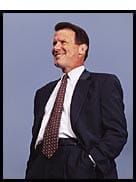Wharton’s tremendous strength and leadership over time has been built on each generation standing on the shoulders of the ones that came before.
In this respect I want to express our deepest appreciation to Jon Huntsman for his extraordinary gift to the School. As you will read in our cover story, Jon is truly a unique individual. His values, ideals, accomplishments, public service and  philanthropy make him a shining example for all of the thousands of Wharton students that we send out each year into leadership positions around the world. His tremendous commitment will enable us to take a significant step forward in sustaining Wharton’s strength well into the future.
philanthropy make him a shining example for all of the thousands of Wharton students that we send out each year into leadership positions around the world. His tremendous commitment will enable us to take a significant step forward in sustaining Wharton’s strength well into the future.
Another aspect of Wharton’s longstanding leadership is our outstanding Marketing faculty. Several studies have shown that Wharton’s Marketing Department is the most published and the most cited, and has more faculty on editorial boards of the leading journals in the field than any other school. Historically, the department has been an innovator and leader — dating as far back as the 1920s.
At that time, Herbert Hess, who chaired the School’s marketing — then called “merchandising”— department was among the first to explore the psychological aspects of marketing. Hess studied such issues as crowd psychology, attention spans and memory — and their implications for companies that want to sell products. He was among the earliest marketing experts to advocate that companies should adapt products to customer needs.
Wroe Alderson built on these foundations during the 1940s and 1950s. A former consultant who entered academia and became the leading marketing theoretician of his time, Alderson was assisted by his colleague, Reavis Cox, and in 1948 wrote a path-breaking essay titled “Towards a Theory of Marketing.” Alderson recognized that mathematical models and quantitative techniques could be used to research such issues as analyzing consumer taste, the size of advertising budgets and sales forces, and the distribution of marketing messages across media. These innovative techniques helped create the field of market research.
Alderson’s collaborator, Paul E. Green, now the Sebastian E. Kresge Professor of Marketing at Wharton, continued this tradition. He created the method of “conjoint analysis” in marketing research, a technique that requires survey respondents to make tradeoffs between various product features. During the 1960s and 1970s, as conjoint analysis became a powerful research tool used throughout the industry, Green became one of the most widely cited authors in marketing. He has won several industry honors, including the Lifetime Achievement Award in Marketing Research from the American Marketing Association.
As we stand on the cusp of a new millennium, we continue to live up to this tradition. The emergence of the Internet is transforming market research, and technology makes it possible to study consumer behavior in unprecedented detail. The Wharton Electronic Commerce Forum, directed by Eric Johnson, David W. Hauck Professor of Marketing, is conducting leading-edge research in this area. With help from faculty around the school, the Electronic Commerce Forum is studying issues ranging from profitability on the Internet to questions of web design and the impact of government regulation. The forum also studies consumer behavior on the Internet through the Wharton Virtual Test Market, a study that covers some 10,000 web-users in more than 70 countries.
Herbert Hess and Wroe Alderson would be proud to see their commitment to marketing and to Wharton being carried on by a new generation.
![]()
Thomas P. Gerrity
























